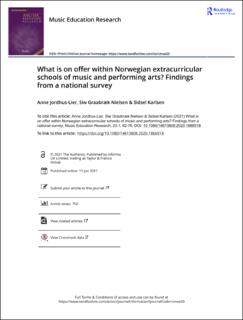What is on offer within Norwegian extracurricular schools of music and performing arts? Findings from a national survey
Peer reviewed, Journal article
Published version

Date
2021Metadata
Show full item recordCollections
Abstract
This article presents the results of a survey among rectors of schools of music and performing arts in Norway. The aim was to map the schools’ offerings in terms of musical genres and related instruments and ensembles, and to determine how the availability of different genres was distributed demographically and geographically. A questionnaire including structured and open-ended questions was sent electronically to all rectors in August 2019 (response rate 58.4%, or 227 out of 389 rectors). The rectors were selected for the survey because they were the ones that had the complete overview of their school’s offerings. The data were analysed statistically and qualitatively. The results show that popular music and Western classical music occupy almost equal space in the schools; popular music is slightly more available. Norwegian folk music and other genres have more marginalised positions. The distribution correlates with patterns of social class and local, regional, and assumed cultural-musical identities, but no unequivocal governing logic of access was found. The findings were interpreted against a Bourdieusian-inspired framework that highlights the symbolic meanings of music.
Description
© 2021 The Author(s). Published by Informa UK Limited, trading as Taylor & Francis Group
Journal
Music Education Research
Except where otherwise noted, this item's license is described as Attribution-NonCommercial-NoDerivatives 4.0 Internasjonal
Related items
Showing items related by title, author, creator and subject.
-
Knowing music as representation or as operation: Exploring musical diversity through collaborative music making in Kaleidoscope
Kvaal, Camilla (Peer reviewed; Journal article, 2021)A society considered to be in a multicultural condition is likely to condition the way things are seen and what is seen as important. Attention is likely to be drawn to difference and diversity and the prospects of including ... -
Children's subject positions in discourses of music in everyday life: Rethinking conceptions of the child in and for music education.
Vestad, Ingeborg Lunde (Journal article; Peer reviewed, 2014)In this article I discuss children’s everyday uses of recorded music (such as CDs, Mp3-files) in the light of sociological notions of “children” and “childhood”. The discussion provides perspectives on musical engagement ... -
Pop Music for Kids: Sonic Markers as Narrative Strategies in Children’s Music
Askerøi, Eirik (Journal article; Peer reviewed, 2017)Whilst the creative handling of recording technology has played a major role in the development of popular music, there has been little research into the role of production in music promoted explicitly for a child audience. ...
